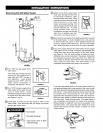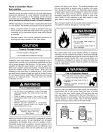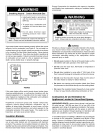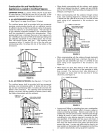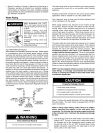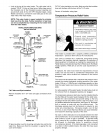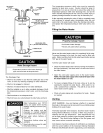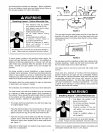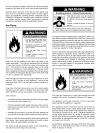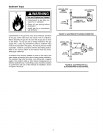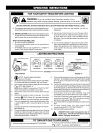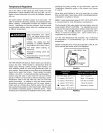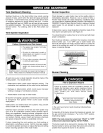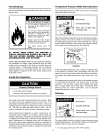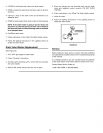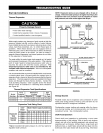
Besureventpipeisproperlyconnectedtopreventescapeof
dangerousfluegaseswhichcouldcausedeadlyasphyxiation.
Chemicalvaporcorrosionoftheflueandventsystemmay
occurif airforcombustioncontainscertainchemicalvapors.
Spraycanpropellants,cleaningsolvents,refrigeratorandair
conditionerrefrigerants,swimmingpoolchemicals,calcium
andsodiumchloride,waxes,bleachandprocesschemicals
aretypicalcompoundswhicharepotentiallycorrosive.
Gas Piping
Breathing Hazard - Carbon Monoxide Gas
• High altitude orifice must be installed
for operation above 3,300 ft. (1,006 m)
or 5,500 ft (1,676 m) for a high altitude
models.
• Contact a qualified installer or service
agency.
Breathing carbon monoxide can cause brain damage or
death. Always read and understand instruction manual.
Fire and Explosion Hazard
• Do not use water heater with
any gas other than the gas
shown onthe rating plate.
• Excessive pressure to gas
control valve can cause serious
injury or death.
• Turn off gas lines during
installation.
• Contact qualified installer or
service agency
Make sure the gas supplied is the same type listed on the
model rating plate. The inlet gas pressure must not exceed
14 inch water column (3.5kPa) for natural and propane gas
(L.P.). The minimum inlet gas pressure listed on the rating
plate is for the purpose of input adjustment. If the gas control
valve is subjected to pressures exceeding 1/2 pound per square
inch (3.5kPa), the damage to the gas control valve could result
in a fire or explosion from leaking gas.
If the main gas line shut-off serving all gas appliances is used,
also turn "OFF" the gas at each appliance. Leave all gas
appliances shut "OFF" until the water heater installation is
complete.
A gas line of sufficient size must be run to the water heater.
Consult the current edition of National Fuel Gas Code ANSI
Z223.1/NFPA 54 and your gas supplier concerning pipe size.
If a standard model is installed above 3,300 feet (1,006 m) or a
high altitude model is installed above 5,500 feet (1,676 m) the
input rating should be reduced at the rate of 4 percent for each
1,000 feet (305 m ) above sea level which requires replacement
of the burner odfice in accordance with National Fuel Gas Code
ANSI Z223.1/NFPA 54. Contact your local Sears Service Center
or local gas supplier for further information.
Failure to replace the standard orifice with a high altitude orifice
when installed at elevations above 3,300 feet (1,006 m) or
above 5,500 feet (1,676 m) for high altitude model) could result
in improper and inefficient operation of the appliance, producing
carbon monoxide gas in excess of safe limits, which could
result in serious injury or death. Contact your local Sears Service
Center or local gas supplier for any specific changes which
may be required in your area.
Fire and Explosion Hazard
• Use joint compound or tape
compatible with propane
• Leak test before operating
heater
• Disconnect gas piping and
shut-off valve before pressure
testing system.
There must be:
• A readily accessible manual shut off valve in the gas supply
line serving the water heater, and
• A ddp leg (sediment trap) ahead of the gas control valve to
help prevent dirt and foreign materials from entering the
gas control valve.
• A flexible gas connector or a ground joint union between the
shut off valve and control valve to permit servicing of the unit.
Be sure to check all the gas piping for leaks before lighting the
water heater. Use a soapy water solution, not a match or open
flame. Rinse off soapy solution and wipe dry.
The minimum inlet gas pressure shown on the rating plate is
that which will permit firing at the rated input.
Use pipe joint compound or teflon tape marked as being
resistant to the action of petroleum (Propane [L.P.]) gases.
16
The appliance and its gas connection must be leak tested
before placing the appliance in operation.
The appliance and its individual shut-off valve shall be
disconnected from the gas supply piping system during any
pressure testing of that system at test pressures in excess of
1/2 pound per square inch (3.5 kPa). It shall be isolated from
the gas supply piping system by closing its individual manual
shut-off valve during any pressure testing of the gas supply
piping system at test pressures equal to or less than 1/2 pound
per square inch (3.5 kPa).
Connecting the gas piping to the gas control valve of the water
heater can be accomplished by either of the two methods
shown in Figures 19 and 20.



